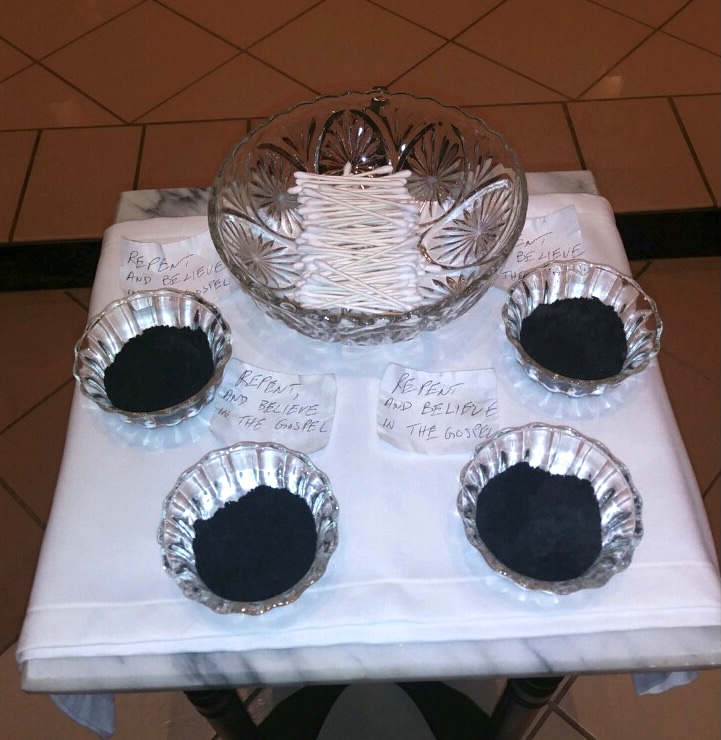So, Mardi Gras came to an end on a very cold night, and a new day awakened, the somber time of Lent. This new day, Feb 17, 2021 long called Ash Wednesday is celebrated throughout the Christian world. Roman Catholics are especially observant of the Ash Wednesday tradition of starting the Lenten season by going to Mass, fasting and receiving ashes on the forehead.
The ashes, applied to the forehead in the shape of a cross, are a symbol of penance, mourning and mortality. Most Catholics wear the ashes throughout the day as a public expression of their faith and penance.

Covid-19 restrictions that were not in place for Ash Wednesday last year have changed the way the Faithful will receive the blessed ashes this year.
Wanting to get the real story about the disbursing of ashes, we went right to the source, Rev. Gary Copping, known locally as Father Gary, the pastor of St. Joseph Church and Shrine in Gretna. A fruitful inquiry as we got a little history lesson along with the skinny on the ashes.
“Ashes have always been in the Old Testament as a sign of repentance. People would show their remorse wearing sackcloth and ashes, like when Jonah walked through Nineveh proclaiming in 40 days Nineveh would be destroyed. The Ninevites and their cattle repented wearing sack cloth and ashes. In the early Church, ashes would be sprinkled by the priest on top of the head of those confessing their sins,” Father Gary said.
“Later in 1091, Pope Urban II decreed that ashes would be sprinkled on the heads of those at the Ash Wednesday liturgy on the first day of the Lenten Season, thus giving this first day of Lent the name “Ash Wednesday.” Ash Wednesday is a day of both fasting and abstinence, coupled with prayer and almsgiving, a practice during Lent that Catholics are encouraged to incorporate into their lives.”
“In most countries of the world, ashes are sprinkled on top of the head. We, in the United States, developed the customer of signing a cross on the forehead with ashes saying the words “Repent and believe in the Gospel” or “Remember that you are dust and unto dust you shall return.”
“The ashes come from the burnt palms from the previous Palm Sunday of the Passion palms, and, LOL, not from the dusty urn of Uncle Johnnie sitting on the mantle-piece that no one got around to burying!” he said.

“For the Archdiocese of New Orleans, there are four options available for the ashes: 1) sprinkling the top of the head with ashes, 2) using a cotton swab to place ashes on the forehead, 3) using a cotton ball to place ashes on the forehead and 4) having the recipient use an alcohol wipe to clean the forehead before the minister applies the ashes with the thumb to the person’s forehead in the sign of the cross.
“We, at St Joseph, will be using the cotton swab, aka Q-tip, to mark the foreheads of the recipients whereby a new swab will be used on each person and the used swab thrown away. We have used the cotton swab or Q-tip for the Anointing of the Sick to anoint on the forehead because of the risk of the spread of Covid and it worked out well, so we will do the same with the ashes.
Thus begins the season of Lent, a recognized season of grief for Christians throughout the world. For Roman Catholics during this penitential season in preparation for Easter, it is a time “to raise up,” “sacrifice” and “offer” to embrace one’s baptismal commitment.
Blessed ashes will be distributed to the Faithful on Feb. 17 at St. Joseph Church and Shrine, 601 6th St. in Gretna during Masses at 8:00 a.m., 12:10 p.m. and 6:30 p.m.

Ashes will also be distributed at the 8:30 a.m. Mass at St. Anthony Church, 924 Monroe St. in McDonoghville. St. Cletus Church, 3600 Claire Avenue will disburse ashes at 9 a.m. and 6:30 p.m. Masses, and ashes will be given at noon, with no Mass.
During the Lenten season all Catholics are encouraged to both fast and abstain in preparation for the Passion and death of the Lord, Jesus Christ.
Traditionally Catholics abstain from eating meat on Ash Wednesday and on all Fridays throughout the Lenten season beginning at age 7.
The custom is to fast on Ash Wednesday and Good Friday from 18 years until 59. These are the ages for this particular ritual that is recommended by the Church, but medical or hardships may apply.
Catholics believe that fasting and abstinence are ways to partake in the wonderful mystery of the Passion of Christ, the giving of his life in obedience to his Father who came in sacrifice to show his love for us.
Don’t give up chocolate this Lent! Think out of the box! Try a spiritual journey with inspiration during Lent from prayer and the reading of Scripture, as well as giving of alms and fasting. One can also fast from luxuries, material goods or certain habits and activities during Lent.
As the universal church observes this special Year of St. Joseph as proclaimed by the Holy Father, the Archdiocese of New Orleans calls upon St. Joseph’s powerful intercession to bring parishioners closer to Jesus in the Eucharist.
There are some events to be noted at the historic church:
Save-the-date of March 19 for the St. Joseph Day Altar. Mass will be celebrated by Archbishop Gregory Aymond at 10 a.m., following by a scaled-down St. Joseph Day Altar in the gym. Guests are invited to view the Altar and accept a take-out dinner and bag of cookies.
Save-the-Date of March 26 for a Lenten Fish Fry in the St. Joseph Church parking lot at Sixth and Newton Streets, sponsored by the Society of St. Vincent de Paul.
Save-the-Date of March 22, 23 and 24 for the “Catholic Social Teaching 101 Lenten Mission.”
Save-the-Date of April 3, Easter Saturday for the “Shop the Huey-Easter” at the Gretna Cultural Center for the Arts where the St. Joseph Restoration peeps will have on hand the newly created “Belltower” ornaments.
###



